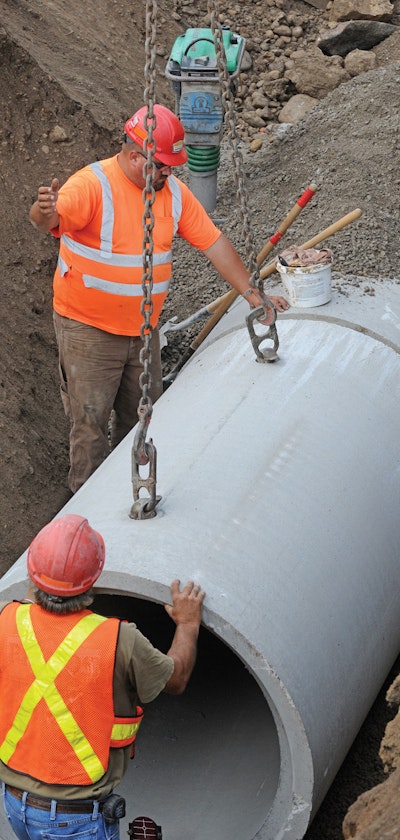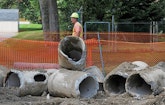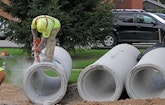
Interested in Manholes?
Get Manholes articles, news and videos right in your inbox! Sign up now.
Manholes + Get AlertsThree years ago, the City of Guelph, Ont., found itself in a unique position. After various levels of government announced funds for an infrastructure stimulus program, the city was offered enough funding to complete five years of combined sewer and roadwork projects for about one-third the regular price.
The catch: all of the work had to be substantially completed inside of 18 months. What followed was an intensive effort to stick to construction schedules, keep traffic moving and citizens informed during the heaviest construction in the city’s history. Having an accurate assessment of the sewer and water infrastructure and a well-developed asset management plan helped to keep the projects on track.
The funding offer originally came from Canada’s federal government, and the province of Ontario kicked in a matching grant.
“We essentially submitted all of the shovel-ready projects we had available and were surprised to see that they were all approved,” says Don Kudo, P.E., manager of infrastructure planning, design and construction with the city.
The projects were carried out in addition to the routine sewer and water main work already planned that year, since the government funding only applied to infrastructure projects that had not yet gone forward.
“We put a few previously scheduled projects on hold due to conflicts and workload, knowing we could return to them later,” says Kudo. “However, we also moved some projects up when it seemed they would work well with the stimulus projects.”
Spurring construction
In June 2009, the governments of Canada and Ontario awarded Guelph a total of $44.4 million (Canadian) to upgrade sewers, water mains, roads, transit infrastructure and municipal buildings. The city contributed an additional $24 million.
Of the 25 projects approved, 17 involved combined sewer and water main work. The goal was substantial completion of more than 28,000 feet of water mains, 21,000 feet of sanitary sewers, 19,000 feet of storm sewers, and more than eight miles of roads by an initial deadline of March 31, 2011. To show good faith, the city had to pay all bills for the projects up front — reimbursement depended on the projects being completed on time.
Guelph typically packages road construction and sewer main work as a single contract. If the project is primarily sewer or water main work, the contractor engages a subcontractor to complete the roadwork, and vice versa.
“For the past 10 years we’ve been carefully coordinating road and water infrastructure work to achieve the greatest efficiency,” says Richard Henry, general manager/city engineer, planning, engineering and environmental services with the city. “We always look at the condition of the water infrastructure as we move ahead.”
Water lines are generally buried about five feet deep. That allows at least one road lane to be left open during replacement or repair. However, sanitary lines run 12 to 15 feet deep, so shoring and barrier requirements mean traffic usually must be rerouted.
“About 80 percent of Guelph’s sanitary sewer infrastructure is more than 50 years old,” says Kudo. “Before the announcement of the stimulus program, we had completed a two-year program of camera inspection of our storm and sanitary sewers, covering about one-third of the city as part of a plan to complete camera inspection of the entire system. The CCTV inspections, performed by a third-party contractor and consultant, revealed that much of the clay pipe infrastructure was deteriorating. The joints were not great even if the pipes themselves were functional.”
Likewise, about 70 percent of the water mains were more than a half-century old, and about 40 percent of the mains were cast iron.
“In some cases, soil conditions have caused the iron lines to deteriorate, but in other cases it’s simply the age of the lines and normal deterioration,” says Kudo.
“However, as we install new mains, we’re using primarily PVC. We considered some options to do cured-in-place lining, but considering the extent of the excavation for roadwork, it made more sense to use open-cut construction techniques.”
Overheated market
City engineers realized that flooding the market with tenders would reduce the competitiveness of some bids. Many contractors were considering work not only in the Guelph area but also in other nearby cities benefiting from stimulus funds.
“In a normal year, our capital program generally runs in the neighborhood of $20 million,” says Henry. “The contractors and consultants knew as well as everybody else that the stimulus funds were available, but we had already worked the costs of heating up the construction market into our plans. We saw a slight increase in prices overall.”
Contractors bid on each separate project, and some won multiple bids. Project values ranged from about $1.1 million to $8.4 million. A typical contract description: “Replace sanitary sewers, water mains, storm sewers, curb and gutter, sidewalk and roadway, traffic signals and add bike lanes.” The city engaged the services of seven engineering companies to help frame the tenders and to help manage the work, under the direction of four project managers.
Work on some of the projects began in fall 2009, and all the projects were in full swing by spring 2010, under the banner: “Guelph Remastered — It’ll be worth it.”
Citizen involvement
While City of Guelph staff and contractors waged a battle against the clock to complete a slate of challenging sewer and road construction projects in time for a funding deadline, the city’s communications specialist organized a public information program to keep citizens informed and involved (see sidebar).
“When we learned that we had received so much money under the infrastructure stimulus programs, we plotted all of the work on a map of the city,” says Stacey Hare, senior communications and issues management coordinator with the city. “At that point we realized this was going to a be a different year in the life of the city than any we’d experienced in a long time, and that we had to do something to minimize the shock.”
The information campaign was necessary because the traffic impacts alone were immense.
“A lot of the projects involved arterial roads, and there was not a single transit route that wasn’t affected by construction,” says Kudo. “We kept in close contact with the city’s traffic services so they could post detour and alternate direction signs.”
Project managers maintained close contact with contractors, holding weekly site meetings to ensure that timelines and budgets were met. Despite the immensity of the effort, Kudo notes that the projects were relatively trouble-free.
“We have a strong asset management program in place, and we already knew the condition of our sewers and water mains,” says Kudo. “Our water works staff had to make some minor adjustments to valving, but they were very quickly able to analyze the impacts of each project on the entire system, using water flow modeling.”
All new construction was tagged with geographic information system (GIS) data to make sure the infrastructure immediately became part of the asset management system.
The city uses GIS-based Info-Water and InfoSWMM software by Innovyze for water and wastewater modeling, respectively. GIS software systems are supplied by Esri.
Extension offered
During the term of the project, as the end of the year approached, the federal government announced an extension of the substantial completion date to Oct. 31, 2011.
“We were right on schedule with the sewer, water and roadwork, but the extension was great news for Guelph regarding the transit and railroad bridge projects we were also completing at the same time,” says Henry. “This also gave us a chance to perform some of the work in the warmer spring weather.”
Work was completed to the satisfaction of government agencies by the new deadline; only some landscaping, paving and road line marking were left to complete.
Kudo’s advice to communities that find themselves in Guelph’s position: “Always have a slate of shovel-ready projects sitting on the shelf. In this case, the scope of the work was already defined, and we just needed consultants to come in and provide detailed design. If funding is offered, you’ve got projects that are ready to move ahead.”









